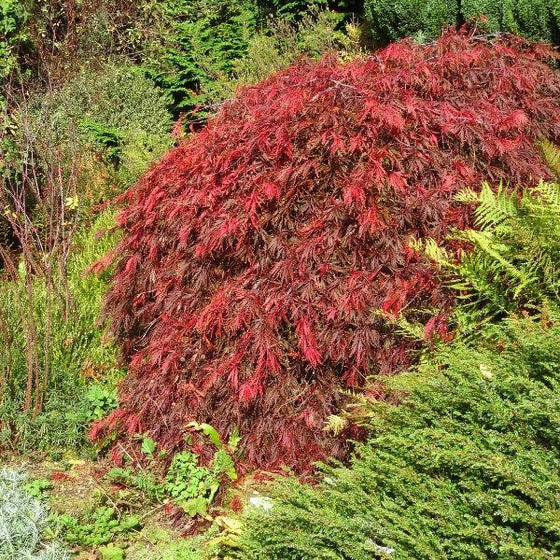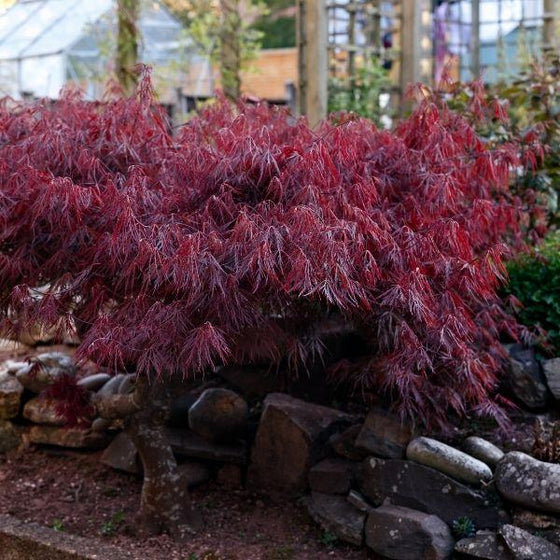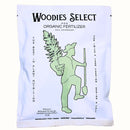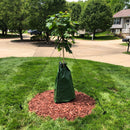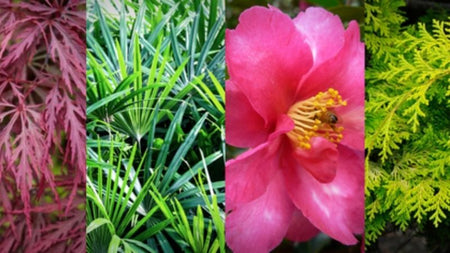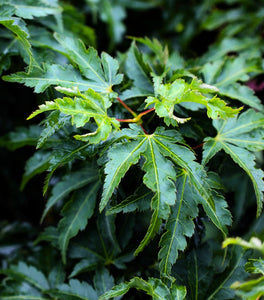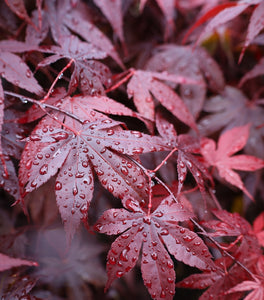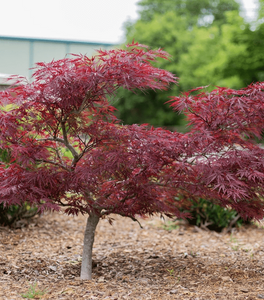
Images Depict Mature Plants
Crimson Queen Japanese Maple
Crimson Queen Japanese Maple (Acer palmatum dissectum ‘Crimson Queen’) is one of the most beloved weeping laceleaf maple varieties, prized for its rich, deep red foliage and graceful, cascading form. From spring through fall, Crimson Queen maintains its stunning burgundy color, standing out as a dramatic focal point in any garden or landscape. In the fall, the foliage transforms into even more intense shades of crimson and scarlet, creating a breathtaking seasonal display. Growing to a mature height of 6 to 10 feet with a similar spread, its compact, mounded habit makes it perfect for patios, entryways, pondsides, and small garden spaces.
Thriving in partial sun to partial shade, Crimson Queen Japanese Maple prefers rich, well-drained soil with a slightly acidic pH to support its vibrant color and fine, lace-like leaf texture. This slow-growing, low-maintenance variety is ideal for specimen planting, container gardening, and adding elegance to Japanese-inspired landscapes or mixed borders. Its finely dissected foliage and artistic, arching branches bring a soft, flowing texture to any outdoor setting. With protection from harsh afternoon sun and consistent watering, Crimson Queen will retain its brilliant color and healthy form year after year.
Whether used as a dramatic centerpiece or a graceful accent among perennials and evergreen shrubs, Crimson Queen Japanese Maple adds timeless beauty, vibrant color, and refined texture to the landscape. Its manageable size and elegant habit make it a favorite for gardeners and landscape designers seeking a show-stopping, low-maintenance tree. With the right care, Crimson Queen will reward you with four seasons of interest and a garden highlight that brings sophistication, movement, and color to any outdoor space.
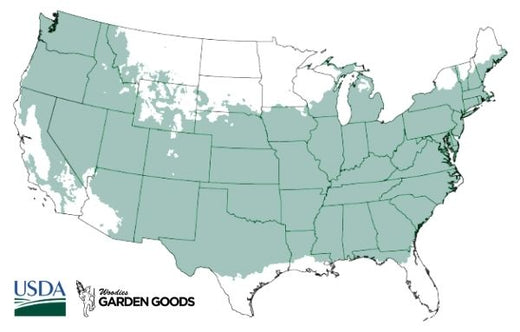
| Hardiness Zone: | 5-8 |
|---|---|
| Mature Height: | 6 to 10 Feet |
| Mature Width: | 8 to 10 Feet |
| Classification: | Small tree |
| Sunlight: | Full Sun to Part Shade |
| Habit: | Deciduous, Weeping |
| Flower Color: | Insignificant |
| Foliage: | Dark purplish-Red Foliage |
| Soil Condition: | Any well drained soil |
| Water Requirements: | Water well until established |
| Uses: | Extremely attractive when used as a focal point or a specimen planting, very heat tolerant |
How to Care for Crimson Queen Japanese Maple
Before you buy a Crimson Queen Japanese Maple Tree, make sure to read about the recommended care instructions to keep this plant healthy and thriving.
How do I Plant my Crimson Queen Japanese Maple?
To plant your Crimson Queen Japanese Maple successfully, choose a location with partial sun to partial shade, providing morning sunlight and protection from intense afternoon heat. The soil should be rich, well-drained, and slightly acidic to neutral for optimal growth and vibrant foliage color. Dig a hole twice as wide and just as deep as the root ball, making sure the top of the root ball sits slightly above the surrounding soil level to encourage proper drainage. Gently loosen the roots if they are circling, position the tree carefully, and backfill with a mixture of native soil and organic compost to support healthy root development. Water thoroughly after planting to settle the soil and eliminate air pockets around the roots. After planting your Crimson Queen Japanese Maple, apply a 2–3 inch layer of organic mulch around the base to retain soil moisture, regulate soil temperature, and suppress weed growth—keeping the mulch a few inches away from the trunk to prevent rot. Water consistently during the first growing season, ensuring the soil remains evenly moist but not waterlogged. With careful planting and proper placement, your Crimson Queen will quickly establish itself, showcasing its stunning burgundy-red laceleaf foliage and flowing, elegant form, making it a striking focal point in any landscape or garden design.
How Should I water my Crimson Queen Japanese Maple Tree?
Watering your Crimson Queen Japanese Maple correctly is essential to maintaining its vibrant burgundy foliage and healthy, cascading form. During the first growing season, water deeply two to three times per week to help establish a strong, deep root system. Focus on soaking the soil slowly at the base of the tree rather than frequent, shallow watering, which can lead to weak surface roots. Using a soaker hose or drip irrigation system delivers steady moisture directly to the root zone, promoting healthy growth and minimizing the risk of fungal issues caused by wet foliage. Once established, your Crimson Queen Japanese Maple will require less frequent watering but should still be monitored during hot, dry periods, especially in summer. Always check the top few inches of soil—if it feels dry, it’s time to water deeply again. A 2–3 inch layer of organic mulch around the base helps retain moisture, regulate soil temperature, and reduce watering needs. Consistent, proper watering not only supports the tree’s health and brilliant seasonal color but also ensures the graceful, weeping form that makes Crimson Queen a stunning centerpiece in gardens, patios, and landscaped beds.
How should I Fertilize my Crimson Queen Japanese Maple?
Fertilizing your Crimson Queen Japanese Maple properly is key to supporting its vivid burgundy foliage, steady growth, and overall health. In early spring, just before new growth emerges, apply a slow-release, balanced fertilizer such as a 10-10-10 formula or one specially formulated for trees and shrubs. Spread the fertilizer evenly around the drip line of the tree, being careful to keep it several inches away from the trunk to avoid root burn. After application, water thoroughly to help the nutrients penetrate the soil and reach the roots. Avoid using high-nitrogen fertilizers, which can cause rapid, weak growth and diminish the tree’s naturally elegant form. For continued vigor, you can also enrich the soil with organic amendments like compost, aged manure, or finely shredded mulch, which not only feed the soil but also help maintain a slightly acidic pH preferred by Japanese maples. If your Crimson Queen is growing in a container or sandy soil, a light mid-summer feeding can be beneficial. Always fertilize moderately, as overfeeding can stress the tree and reduce its vibrant leaf color. With a consistent and thoughtful fertilization schedule, your Crimson Queen Japanese Maple will thrive, showcasing stunning lace-like foliage and cascading form throughout the seasons.

How and When Should I Prune My Crimson Queen Japanese Maple?
Pruning your Crimson Queen Japanese Maple should be done carefully to enhance its natural, cascading form and promote healthy, vibrant growth. The best time to prune is in late winter to early spring, just before the new leaves emerge but after the threat of severe frost has passed. Start by removing any dead, damaged, or crossing branches using clean, sharp pruning shears. Light thinning of crowded areas improves air circulation and sunlight penetration, which helps maintain healthy foliage and prevents fungal issues. Always make precise cuts just above a bud or branch junction to encourage clean, healthy regrowth. You can also perform light touch-up pruning in early summer once the leaves have fully developed, allowing you to refine the tree’s graceful, flowing shape. Avoid heavy pruning in late summer or fall, as it can stimulate tender new growth that may not harden before winter. When pruning your Crimson Queen Japanese Maple, the goal is to preserve and enhance its natural weeping habit, not drastically reshape it. With careful, minimal pruning each year, your Crimson Queen will maintain its stunning laceleaf appearance, rich burgundy color, and elegant cascading silhouette, making it a breathtaking centerpiece in any landscape.



